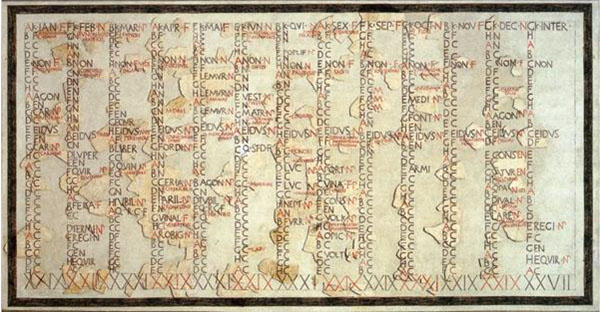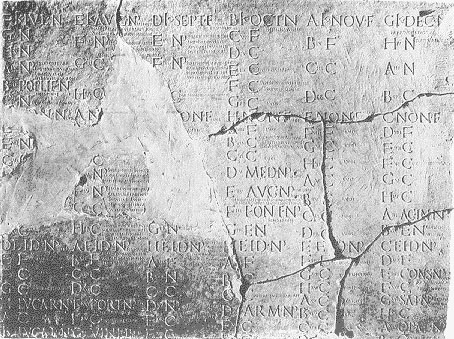Introduction
Assumptions are dangerous, particularly when they are made in the realm of religion. If a belief is based on a faulty assumption, the "logical conclusion" will be in error. Christians who worship on Sunday base this practice on the belief that Christ arose from the tomb on Sunday. Jews and Christians who worship on Saturday do so because it is the seventh day of the week. Both parties base their belief, and thus their practice, on an assumption.
The assumption is that because the progression of days was not changed at the time the Julian calendar transitioned to the Gregorian, the modern week is identical to the Biblical week. Therefore, the "logical conclusion" is that Saturday is indeed the Bible Sabbath and Sunday is the day on which Christ arose from the grave. The facts of the Julian calendar itself, however, prove this assumption is false.
A well-known adage is that those who forget history are doomed to repeat the mistakes of history. Likewise, those who have never learned the facts of calendar history have built an entire belief structure on a faulty foundation: the assumption that weeks have cycled continuously and without interruption ever since Creation. It is of vital importance to all, regardless of their religion, to study the history of the Julian calendar. Assembling the missing puzzle pieces of historical fact reveals when a continuous weekly cycle of seven days became the standard measurement of time – and it was not at Creation.
Julian Calendar Established
The calendar of the Roman Republic was based on lunar phases. Pagan Roman priests, called pontiffs, were responsible for regulating the calendar. Because the pontiffs could also hold political office, it provided opportunity for abuse. Intercalating.1an extra month could keep favored politicians in office longer, while not intercalating when necessary could shorten the terms of political opponents.
By the time of Julius Cæsar, months were completely out of alignment with the seasons. Julius Cæsar exercised his right2as pontifex maximus 3(high priest) and reformed what had become a cumbersome and inaccurate calendar.4
In the mid-1st century B.C. Julius Cæsar invited Sosigenes, an Alexandrian astronomer, to advise him about the reform of the calendar, and Sosigenes decided that the only practical step was to abandon the lunar calendar altogether. Months must be arranged on a seasonal basis, and a tropical (solar) year was used, as in the Egyptian calendar . . . .5
Notice that Sosigenes' big innovation was an abandonment of lunar calendation:
The great difficulty facing any [calendar] reformer was that there seemed to be no way of effecting a change that would still allow the months to remain in step with the phases of the Moon and the year with the seasons. It was necessary to make a fundamental break with traditional reckoning to devise an efficient seasonal calendar.6
To bring the new calendar into alignment with the seasons required adding an additional 90 days to the year. This was done in 45 B.C., creating a year of 445 days. "This year of 445 days is commonly called by chronologists the year of confusion; but by Macrobius, more fitly, the last year of confusion."7The first puzzle piece in establishing the truth of the calendar, is to realize that the Julian week of 45 B.C., did not look like the Julian week when Pope Gregory XIII modified it, and thus did not look like the modern Gregorian week of today. This is the first assumption made by both Jews and Christians, regardless of the day on which they worship.8
The Julian calendar, like the calendar of the Republic before it, originally had an eight-day cycle.
The Roman eight-day week was known as internundinum tempus or "the period between ninth-day affairs." (This term must be understood within the context of the ancient Roman mathematical practice of inclusive counting, whereby the first day of a cycle would also be counted as the last day of the preceding cycle. )9The "ninth-day affair" around which this week revolved was the nundinæ, a periodic market day that was held regularly every eight days.10
Early Julian calendars were not constructed in grids as are modern calendars, but the dates were listed in columns, with the days of the week designated by the letters A through H.11For example, January started with day "A" and would proceed through the eight days of the week, with the last day of the month being day "E." Unlike the Hebrew calendar, the Roman calendar had a continuous weekly cycle. Because January ended on day "E", February began on day "F". Likewise, February ending on day "A" started March off on day "B":
| A k12 Jan | F k Feb | B k Mar |
| B | G | C |
| C | H | D |
| D | A | E |
| E, etc. | B, etc. | F, etc. |
Following is a reconstruction13of the Fasti Antiates, the only known pre-Julian calendar still in existence14dating from the 60s B.C. found at the site of Nero's villa in Antium.

Fasti Antiates – reconstruction of the only known pre-Julian calendar in existence.
This calendar was painted on plaster with the letter A painted red to indicate the start of the week. The months are arranged in 13 columns. January, on the left, begins on day "A" and ends on day "E". At the bottom of each column are large Roman numerals showing the number of days in that month. The far right hand column is the 13th, , intercalary month. Additional letters appear beside the week-day letters. These indicated what sort of business could or could not be conducted on that day.
All examples of Julian fasti, or calendars, date from the time of Augustus15(63 B.C. – 14 A.D.) to Tiberius (42 B.C. – 37 A.D.) If the assumption is correct that Saturday is the Bible Sabbath because the weekly cycle was not interrupted at the calendar change from Julian to Gregorian, then this should be easily proven from the early Julian calendars still in existence. An example of a Julian fasti is preserved on these stone fragments and provides the second, confirming piece of the puzzle in establishing the truth of calendar history. The eight-day week is clearly discernible on them verifying that the eight-day week was still in use by the Romans during and immediately following the life of Christ.

It is important to remember that the Biblical week as an individual unit of time defined in Genesis 1, consisted of only seven days: six working days followed by a Sabbath rest on the last day of the week. The eight-day cycle of the Julian calendar was in use at the time of Christ. However, the Israelites would not have kept the seventh-day Sabbath on the eight-day weekly cycle of the Julian calendar. This would have been idolatry to them. Even when the Julian week shortened to seven days, it still did not conform to the weekly cycle of the Biblical week nor did it resemble the modern week in use today.
1Intercalation: inserting extra days or months to align the shorter lunar year to the longer solar year. Because intercalation was thought to be "unlucky", during the Second Punic War (218-201 B.C.) the priests hesitated to make changes, thus throwing the calendar slightly off the seasons.
2Julius Cæsar had been elected pontifex maximus in 63 B.C. (James Evans, "Calendars and Time Reckoning", The History and Practice of Ancient Astronomy, Oxford University Press, 1998, p. 165.)
3"Pontifex Maximus" is now a title reserved exclusively for the pope. This is very appropriate as the Gregorian calendar now in use is both pagan and papal, being founded upon the pagan Julian calendar and modified by, and named after, a pope.
4In order to declare an intercalation, the pontifex maximus had to be in Rome in February. Because Julius Cæsar was involved in various wars, there had been only one intercalation declared since he took office. In a letter to Atticus, dated February 13, 50 B.C., Cicero complained that he still did not know whether there was to be an intercalation later in the month.
5"The Julian Calendar," Encyclopædia Britannica.
6 Ibid., emphasis supplied.
7A Dictionary of Greek and Roman Antiquities, William Smith LL.D., William Wayte, M.A., George E. Marindin, M.A., eds., London, William Clowes and Sons, Ltd., 1890, Vol. I, p. 344. Digitized by Google.
8This assumption is not shared by scholars. Jews admit that the rabbinical calendar now used is not the calendar of Moses, and Christian scholars acknowledge that the Biblical calendar operated differently. Some also admit that when the seventh-day Sabbath is calculated on the Biblical calendar it will not coincide with Saturday.
9J. P. V. D. Balsdon, Life and Leisure in Ancient Rome, (New York: McGraw-Hill, 1969) p. 59; P. Huvelin, Essai Historique sur le Droit des Marcheés et des Foires (Paris: Aruthur Rousseau, 1897), p. 87; Ovid, Fasti (Cambridge, MA: Harvard University Press, 1951), p. 6; Alan E. Samuel, Greek and Roman Chronology (Munich: C. H. Beck'sche Verlagbuchhandlung, 1972), p. 154.
10Eviatar Zerubavel, The Seven Day Circle: The History and Meaning of the Week, (University of Chicago Press, 1985), p. 45.
11Zerubavel, op.cit.,158; Balsdon, op.cit., p. 60; Francis H. Colson, The Week, (Cambridge, England: Cambridge University Press, 1926), p. 4; W. Warde Fowler, The Roman Festivals of the Period of the Republic (Port Washington, New York: Kennikat Press, 1969), p. 8; P. Huvelin, op.cit., p. 88; Alan E. Samuel, op.cit., pp. 153-154; Ovid, op.cit.; Hutton Webster, Rest Days, (New York: MacMillan) p. 123; W. E. van Wijk, Le Nombre d'Or (The Hague: Martinus Nijhoff, 1935), pp. 24-25.
12Kalendæ: the first day of the month.
13Palazzo Massimo Alle Terme, ed. Adriano La Regina, 1998.
14For additional information, see The Calendar of the Roman Republic by A. K. Michels (Princeton, 1957). 15Augustus Cæsar, first Roman Emperor, is mentioned in the Bible. His levy of a tax led Mary and Joseph to Bethlehem just in time for the birth of Yahushua. (See Luke 2:1.) Because of the Roman method of counting inclusively, leap years were intercalated every three years initially. To reconcile the additional time, Augustus decreed that no years were to be intercalated from 8 B.C. to 8 A.D. The eighth month was renamed August in his honor.









